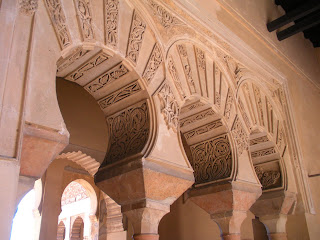Marchena
Marchena reached its splendor under the control of the Ponce de Leon family, better known as the Dukes of Arcos. One of several gates to the old city, this archway dates to the Moorish period but was modified by later Christian occupants.

 City halls (ayuntamientos) : old and new
City halls (ayuntamientos) : old and new
 Parrish churches dating to the immediate post-conquest period.
Parrish churches dating to the immediate post-conquest period.

 The municipal archive/library
The municipal archive/library

Osuna
Originally the Roman colony of Urso, Osuna once boasted its own university. As with the case of Marchena, Osuna owes much of its Baroque splendor to an aristocratic household. Patrons of the arts and education, the Dukes of Osuna built much of the city's monumental zone with an impressive private fortune.
 Courtyard of the municipal archive/library
Courtyard of the municipal archive/library The old university
The old university Inside the Colegiata
Inside the Colegiata
 Residence of the Marquess of Gomera
Residence of the Marquess of Gomera Ancient graveyard
Ancient graveyard











































